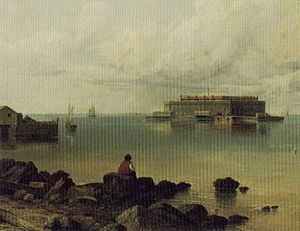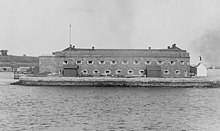Fort Lafayette
40°36′30″N 74°02′19″W / 40.60833°N 74.03861°W
| Fort Lafayette | |
|---|---|
| Hendricks Reef, offshore of | |
 Fort Lafayette, seen from the Brooklyn shore with Denyse's Wharf to the left | |
| Coordinates | 40°36′30″N 74°02′19″W / 40.60833°N 74.03861°W |
| Site history | |
| Built | 1815-1822 |
| Built by | United States Army Corps of Engineers |
| In use | 1822-1946 (ammunition storage after 1897) |
| Materials | sandstone, brick |
| Fate | demolished 1960 |

Fort Lafayette was an
Construction
Fort Lafayette was in the form of a square set on end, hence its first name of Fort Diamond. It held approximately 72 cannon (references vary) in three tiers, two in casemates and one in barbette mountings on the roof. The design allowed all the cannon in the southwest front to engage enemy ships entering the Narrows, with the northwest front also engaging if ships passed the fort. The fort was designed at the very end of the second system of US fortifications, and is not fully characteristic of either the second system or the third system. The fort was built of sandstone and brick. The fort was, however, vulnerable to bombardment from Brooklyn, and Fort Hamilton was built circa 1830 to prevent this.[1] In the 1840s, as a captain in the Army Corps of Engineers, Robert E. Lee worked on repairs and improvements to the fort.[2]
Civil War prison

Before 1861, the fort's 72 heavy
Later use
Rebuilt after a catastrophic fire in 1868, the fort was used in 1883 by
References
- ^ a b Weaver, pp. 140-141
- ^ a b Fort Lafayette at FortWiki.com
- ^ Roberts, pp. 563-564
- ^ The Political Prisoners.; A Day At Fort Lafayette. List Of The Prisoners. Published: September 24, 1861
- ^ The Plot To Burn New-York.; Arrest Of Four Conspirators. They Are To Be Tried As Spies. Court-Martial At Fort Lafayette. Travels of a Hotel-Keeper. The Testimonial Business An Imposition on Ill.-Paid Clerks. The New York Times. Published: 17 January 1865
- ISBN 0-8156-0207-3
- ISBN 1-4179-3078-0
- ^ "Mr. Lincoln and New York". Archived from the original on 2016-03-04. Retrieved 2016-11-30.
- ISBN 0-8232-2345-0.
- ISBN 978-0306719639
- ^ United States War Dept., United States. Record and Pension Office, United States. War Records Office, et al. The War of the Rebellion: a compilation of the official records of the Union and Confederate armies. Series 2 - Volume 2. (Washington, D.C. Government Printing Office, 1894): 778-786.
- Roberts, Robert B. (1988). Encyclopedia of Historic Forts: The Military, Pioneer, and Trading Posts of the United States. New York: Macmillan. ISBN 0-02-926880-X.
- Weaver II, John R. (2018). A Legacy in Brick and Stone: American Coastal Defense Forts of the Third System, 1816-1867, 2nd Ed. McLean, VA: Redoubt Press. ISBN 978-1-7323916-1-1.



